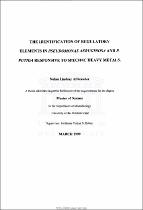| dc.contributor.advisor | Brozel, Volker S | |
| dc.contributor.author | Africander, Nolan Lindsay | |
| dc.date.accessioned | 2023-06-20T09:24:30Z | |
| dc.date.available | 2023-06-20T09:24:30Z | |
| dc.date.issued | 1999 | |
| dc.identifier.uri | http://hdl.handle.net/11394/10308 | |
| dc.description | Magister Artium - MA | en_US |
| dc.description.abstract | Heavy metals constitute a group of about sixty-five elements having a density greater
than five (Gadd and Griffiths, 1978). Some metals, for example lead, copper, and nickel
are extremely precious and profitable to man due to its widespread application in
industry. As there has been an increase in heavy metal demand, necessary development
of elegant and efficient methods for their isolation were also required. These methods,
which led to an increase in industrial development, also resulted in an increase in the
complexity and variety of heavy metals polluting the environment (Morby,1996 | en_US |
| dc.language.iso | en | en_US |
| dc.publisher | University of Western Cape | en_US |
| dc.subject | Copper | en_US |
| dc.subject | Nickel | en_US |
| dc.subject | Microorganisms | en_US |
| dc.subject | Mechanisms | en_US |
| dc.subject | UV-light | en_US |
| dc.title | The identification of regulatory Elements in pseudomonas aeruginosa and p. putida responsive to specific heavy metals. | en_US |
| dc.rights.holder | University of the Western Cape | en_US |

